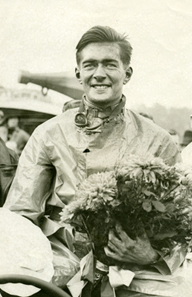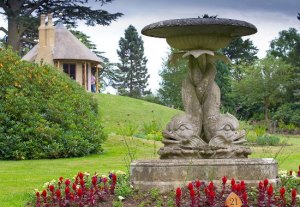The Shuttleworth Collection is a rare gem in what has jokingly been referred to by some as the world’s largest open-air museum (the United Kingdom). It is home to one of the most important private collections of historic aircraft and motor vehicles, whose holdings span a period that stretches from the Victorian to the modern Elizabethan Age. But this eclectic, one-of-a-kind facility is just the tip of the iceberg known as Old Warden.
The Old Warden Estate in Bedfordshire, England, was assembled by the Ongley family in the 18th and 19th Centuries and was subsequently purchased in 1872 by Joseph Shuttleworth, a Lincolnshire industrialist. Founded in 1842 with Nathaniel Clayton, Joseph was a partner in the firm of Clayton & Shuttleworth, agricultural engineers and steam-wagon makers. Their workshops produced a range of equipment that was exported widely. The wealth generated by the company enabled Joseph Shuttleworth to acquire Old Warden Park and the surrounding estate, today home to the Shuttleworth Collection.

Shuttleworth House (© Shuttleworth Collection)
In 1875, Joseph replaced Ongley’s original red brick manor house with an impressive mansion. Built in the Jacobean style, Old Warden House was designed by architect Henry Clutton and features a steel frame reputed to have been made by Clayton & Shuttleworth. Upon Joseph’s death in 1883, his younger son, Frank, inherited the wealth of the Old Warden Estate. An army man who had attained the rank of Colonel, Frank was a keen traveler and breeder of horses. Frank was 57 when he married Dorothy Clotilda, the then 23-year-old daughter of the Vicar of Old Warden.

Dorothy Shuttleworth with Son, Richard, and Daughter, Anne, ca. 1917 (© Shuttleworth Collection)
Richard Ormonde Shuttleworth was born at Old Warden on 16 July, 1909. At the age of 23, Richard Shuttleworth inherited enough money to indulge his twin passions for motor racing and aviation, purchasing, rebuilding and restoring motorcars, motorcycles and aeroplanes from the years immediately prior to and after the Great War.
When war broke out again in Europe in 1939, Richard joined the Royal Air Force and was posted to RAF Benson, near to Benson in South Oxfordshire.

Richard Shuttleworth Winning at Donington Park, 1934 (© Shuttleworth Collection)
Sadly, in the early hours of 2 August, 1940, flying in a cross-country training exercise in a Fairey Battle, he was killed when his plane crashed into a hillside.
In 1944, Richard’s mother, Dorothy Clotilda Shuttleworth, decided to place the Old Warden Estate in a charitable trust in memory of her late son. She wanted to ensure the estate would continue to be used for the purposes of education in the disciplines of agriculture and aviation studies, areas of great personal interest to Richard.
The two principle objectives of the trust were the establishment of a college at Old Warden Park, Bedfordshire, and the development of the Shuttleworth Collection, the unique museum of veteran aeroplanes, cars and other vehicles situated on the adjacent property. Shuttleworth College enrolled its first students in 1946, at the Old Warden House, and soon established its place as a national centre for agricultural education. Since 2009 it has enjoyed a close association with Bedford College. Old Warden House is today a part of the Shuttleworth Collection and frequently hosts weddings and private conferences.

Main Entrance (© Shuttleworth Collection)
The Shuttleworth Collection was first opened to the public in 1963. Annual events that encompass flying displays and vehicle parades draw crowds to Old Warden from across the British Isles and from around the world.

1912 Blackburn Monoplane (Foreground), Bristol Boxkite (Background), Lilienthal Glider (Above) (© Vidi-Visions Productions)
Exhibits contained within the Collection include replicas of gliders from the mid-1890s built by German engineer Otto Lilienthal, and run to fixed-wing aircraft from as late as the 1950s. Equipment on display is largely of British design.
Notable exceptions, however, include a genuine Blériot Model XI dating from 1909, acknowledged as the world’s oldest airworthy aeroplane.

Bristol F.2B Fighter (© Vidi-Visions Productions)
Other historic aircraft include the actual de Havilland DH.88 Comet, Grosvenor House, which won the MacRobertson England-to-Australia air race in 1934, genuine examples of a Bristol F.2B Fighter and a Royal Aircraft Factory S.E.5a of the First World War, two Hawker Hurricanes, a Hawker Demon (Hart), the last production Gloster Gladiator, a rare airworthy Westland Lysander, and a newly refurbished Supermarine Spitfire. Aircraft are demonstrated frequently at public and private events, complemented by a dizzying array of historic artifacts on display in each of the Collection’s six hangars.

Westland Lysander (Foreground), Hawker Hurricane (Background) (© Vidi-Visions Productions)
Besides his enthusiasm for aviation, Richard Shuttleworth was also an avid motorist who enjoyed the collection and restoration of vintage motor vehicles. In keeping with his personal philosophy that all such antique equipment be operated as originally intended, the Collection’s vehicles, much like their winged counterparts, are maintained in full running order.

1911 Delage Type X (© Vidi-Visions Productions)
The Collection is home to a variety of Veteran (—1901), Edwardian (1901—1910), and Classic (1911—1948) cars, along with omnibuses, motorcycles, and bicycles of similar vintage, most of which are paraded regularly around the 4,734-acre estate.
Apart from the fantastic equipment contained within the Collection, and the successes of Shuttleworth College, among the more fanciful features of the Old Warden Estate is the Swiss Garden. Created initially between 1824 and 1832 by the 3rd Baron of Old Warden, Lord Ongley, when the garden was first completed he threw extravagant parties. To complete the look Lord Ongley convinced his servants to dress up in traditional Swiss costume.
Excavated soil was used to create embankments that gave the garden its distinctive appearance. In addition, all of the ponds were produced intentionally after a nearby river was dammed. The clever use of earthworks, shrubberies, trees, paths, lakes and follies transformed the garden into what one contemporary observer described as, “a fairyland.”

The Swiss Garden (© Shuttleworth Collection)
In the 20 years between Lord Ongley’s departure in the 1850s and the acquisition of the Old Warden Estate by Joseph Shuttleworth, the garden was neglected. When Shuttleworth purchased the land he made sweeping changes to the property. Having demolished Lord Ongley’s earlier manor house, he commissioned the architect Henry Clutton not only to design the new Old Warden House but to revitalize the Swiss Garden, with the help of respected landscape gardener Edward Milner.

The Swiss Garden (© Shuttleworth Collection)
After the Second World War the Swiss Garden once more fell into disrepair, and by the 1970s it was in a perilous state. Over the next two decades, and again at the beginning of the 21st Century, the garden received much attention. This work bought valuable time for the garden and its many unique buildings. Now that the most recent restoration work has been completed and given a few years to mature, the Swiss Garden has become a window to the past – an authentic snapshot of late-Regency fancy and Victorian sophistication.

The Swiss Garden (© Shuttleworth Collection)
The restoration covered almost every aspect of the garden, from the renewal of paths to the repair of decorative features. It included conservation and refurbishment of all structures, removal of damaged trees and overgrown shrubs, plus new plantings with species that both Lord Ongley and Joseph Shuttleworth would have recognized.
Even the lake that feeds the garden’s ponds was restored, making the water as clear and sparkling as was possible. In a dedicated effort, the garden was taken back to the moment when Shuttleworth completed his first improvements to Lord Ongley’s original Swiss Garden.
In a given calendar year, the Shuttleworth Collection may present between 10 and 12 public displays of its aircraft. These air shows and pageants showcase specific aspects of the Collection’s holdings – showing off these magnificent flying machines to greatest possible advantage, and telling the equally magnificent stories of the men and women who built and flew them.

Hawker Demon (Hart) (© Vidi-Visions Productions)
This singular museum serves as a compelling tribute to the shared legacy of all who served in World Wars One and Two. Veteran planes, whose first crews endured such tremendous hardships as tested the ultimate endurance of man and machine, now sport and play from the very heights from which they once drove the darkest of clouds. The shining aircraft of the Shuttleworth Collection remain the silver lining in the skies above Great Britain.
E-mail vidi.visions.productions@gmail.com for further details.
© Vidi-Visions Productions & The Shuttleworth Collection

